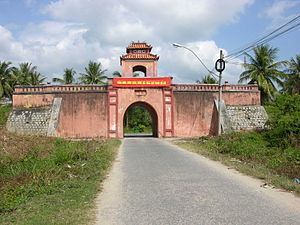Country Vietnam Capital Diên Khánh Area 513 km² Province Khanh Hoa Province | Region South Central Coast Time zone UTC + 7 (UTC+7) Local time Thursday 9:11 AM | |
 | ||
Weather 27°C, Wind N at 18 km/h, 67% Humidity Points of interest Thành cổ Diên Khánh, Cây Dầu Đôi Diên Khánh, DIen Khanh citadel ga, Đài Liệt Sĩ | ||
Diên Khánh is a rural district (huyện) of Khánh Hòa Province in the South Central Coast region of Vietnam. Diên Khánh is one of the oldest citadels in the south of Vietnam and it is one of the precious vestiges for studying ancient citadels. As of 2003 the district had a population of 134,118. The district covers an area of 513 km². The district capital lies at Diên Khánh.
Contents
Map of Di%C3%AAn Kh%C3%A1nh District, Khanh Hoa Province, Vietnam
Diên Khánh Citadel
The Diên Khánh Citadel is situated in Diên Khánh Townlet, Diên Khánh District. The Citadel was built by the French officer Olivier de Puymanel for Nguyễn Ánh in 1793 with an area of 36,000 square meters according to the Vauban military architecture which was popular in Western Europe in 17th - 18th centuries.
The citadel's wall was in an inequilateral hexagon of 3.5m height. The outer face was vertically constructed while the inner was a little bit sloping by two terraces forming a favorable pavement. Inside the corners, there were large fields which were convenient for military resident. On the top of corners there stood fortresses of 2m high with canons above. On the roof of the citadel, there planted closet bamboo and other barricade trees. Surrounding the citadel were moats of 4 to 5 meters deep, 10 meters wide, flooded by water.
At first the citadel had 6 gates but nowadays it remains only 4 ones which are East Gate, West Gate, Front Gate (to the south), Back Gate (to the north). There had been here royal palace, private residents of feudal mandarins, warehouses and jails...
